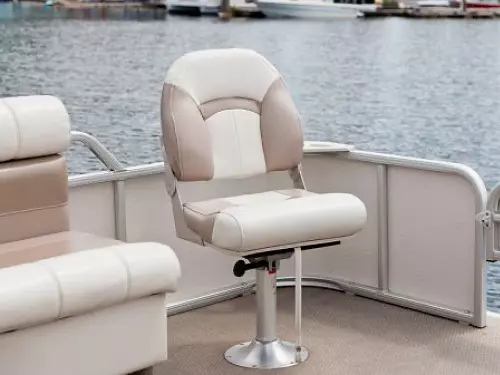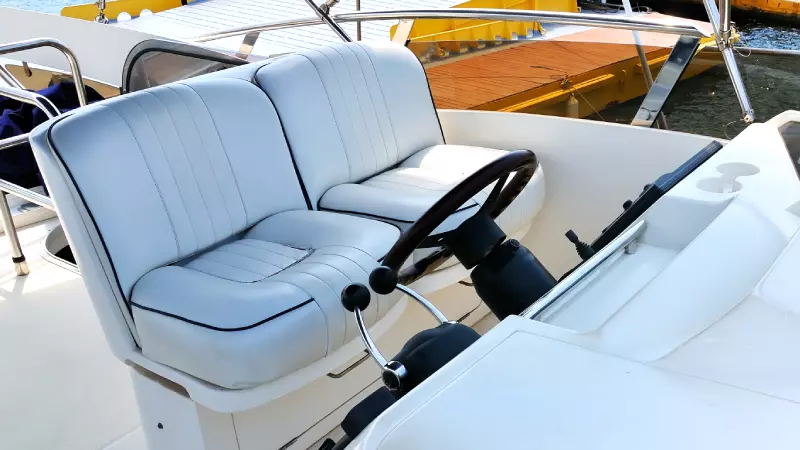How to Remove Mold & Mildew from Leather Boat Seats
Mold and mildew are a type of fungi that thrive in wet and humid environments. If you leave your leather boat seats wet for an extended period, damp and warm environments can foster mold growth.
Boats are generally stored in stale and enclosed environments, which can cause your leather boat seats to get moldy. Mold growth is typically further accelerated when your leather boat upholstery is stored within sealed boat enclosures, due to a lack of ventilation and sunlight.
Mold and mildew stains on leather boat seats can not only lead to discoloration and fading but can also damage them, decreasing their overall lifespan. Therefore, it’s important that you maintain them regularly and also treat mold strains immediately.

The process of removing mold and mildew from upholstery, such as leather boat seats is different from removing mold from vinyl or fabric boat seats. This is because leather is a highly porous material, that mold and mildew can penetrate causing long-term damage to the leather’s fiber structure.
This guide aims to teach you how to clean mildew and mold off leather boat seats with a simple 3-step process. You can achieve this by removing the mold and mildew spores from leather boat seats, cleaning them with a cloth and brush, and finally applying a UV protectant to protect your leather against sun damage.
Here’s a list of things you’ll need:
- 1 x Lint-Free Cloth
- 1 x Rubbing Alcohol
- 1 x Saddle Soap
- 1 x Soft Brush
- 1 x UV Protectant
1. Remove Mold & Mildew Spores from Leather Boat Seats
The most critical step is to remove mold and mildew spores since they can spread quickly if left unattended. You should also separate or isolate the affected parts of the leather upholstery from the unaffected sections since removing mold incorrectly can also lead to dangerous growth in other areas.
After detecting mold on your leather upholstery, begin by brushing away the mold spores using a horsehair brush or any other type of soft brush. Lightly removing the spores with a brush will get rid of the more apparent and significant sections of mold growth.
Ensure to only use light pressure and move on to disinfection once most of the surface mold is cleared.
Removing Stubborn Mold & Mildew Stains
If you see that the mold has penetrated your leather boat seats, then you can also consider disinfecting them. Use a solution of rubbing alcohol with equal parts of water for this. The combination of rubbing alcohol and water will remove any mold that penetrated your leather boat upholstery.
Apply this solution with a lint-free cloth to remove any tough mildew and mold stains. Remember not to use too much pressure, as you want to avoid discoloration and fading.
2. Clean Leather Boats Seats with a Cloth & Soft Brush
For any mold that may have penetrated through the layers of your boat’s leather seats, you need to use a thorough cleaning method. You can use saddle soap or any other leather cleaning solution for the job.
Ensure that the cleaning solution is suitable for leather and will not cause any brittleness or drying. We recommend using Fiebing’s Saddle Soap for cleaning tough and persisting stains caused by mold.
This saddle soap cleans leather properly while nourishing it to retain important oils resulting in a fresh and supple appearance. To clean your leather boat seats, you need to apply saddle soap with a slightly damp cloth. Rub the saddle soap in circular motions to remove them.
Remember to wipe any residue away using a dry cloth. Make sure that you have thoroughly washed the seats and that no mold and mildew stains are visible anymore.
If you want to take an extra precautionary step for protection against mold regrowth, apply a leather conditioner. Just ensure that the conditioner is compatible with leather to avoid any damage to it.
3. Apply a UV Protectant to Your Leather Boat Seats
Lastly, to completely protect your leather boat seats, we recommend that you apply an ultraviolet (UV) protectant. A UV protectant seals the leather pores by forming a protective layer that prevents color fading, brittleness, as well as mold growth.
Since boats are exposed to harsh ultraviolet sun rays, as they cruise in the open sea or are berthed in the marina, a UV protectant can prevent accelerated drying and fading of your leather boat seats.
It also makes cleaning them much easier, since most formulas are dust repellents and also adds a protective coat so that you can simply wipe them down. This will ensure that your boat seats retain their smooth, soft and breathable leather texture.
When it comes to product selection, we recommend using either the TriNova UV Protectant Spray or 303 Aerospace Protectant because they are highly suitable for leather boat seats, except when they’re made of nubuck and suede.
To use a UV protectant simply spray some of the product onto them and wipe the surface dry with a clean cloth.
How to Prevent Mold & Mildew from Forming on Leather Boat Seats
Prevention is better than cure and this statement is also true when it comes to mold and mildew. As this guide mainly focused on removing mold and mildew from leather boat seats, we also wanted to include a section that addresses how you can prevent it in the first place.
- Maintain Your Leather Boat Seats Regularly – All types of leather should be regularly maintained. As mold forms from moisture, it’s important to regularly clean and condition your leather boat seats.
- Store Your Boat Appropriately – As mold and mildew thrive in a damp and moist environment, it’s best to ventilate your boat once in a while, when it’s in storage. This is particularly important if your boat is stored with an enclosure.
- Use Leather Friendly Products – Cleaning and conditioning solutions are designed to nourish your leather and also seal the pores, which in turn helps to prevent mold growth. A good leather conditioner is able to make your boat seats mold-resistant if they are regularly maintained.
If your boat is stored in environments with high or fluctuating humidity levels, we suggest maintaining your leather boat seats more regularly. Leather is a porous material and when not maintained properly, can easily be damaged permanently.
We also want to reiterate that you should not use any type of general cleaning solution or cleaning methods designed for fabric or vinyl boat seats, as these materials behave differently.
Using general cleaning methods or solutions on leather boat seats can remove their oils or any type of protective layer that they have been conditioned with, which could potentially accelerate mold growth.
We hope that this guide was helpful to you and that you were able to easily apply this process. If you have any questions, please feel free to get in touch with us.

About Gerrit
Co-Founder, Researcher & Writer At Leatherskill
I’m a leather enthusiast who spends most of his free time crafting, researching, and writing about the many facets of this versatile material. Thanks for reading!

